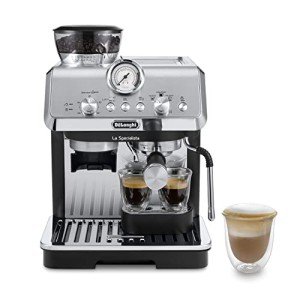Heat Exchange Espresso Machines: A Comprehensive Guide
Espresso machines have actually developed considerably throughout the years, accommodating the requirements of home baristas and coffee specialists alike. Among these machines, heat exchange espresso machines have actually gained popularity due to their capability to provide consistent efficiency and exceptional brew quality. In this post, we will check out the workings, benefits, and important functions of heat exchange espresso machines, offering an extensive understanding for both possible purchasers and coffee lovers.
Understanding Heat Exchange Technology
Heat exchange espresso machines operate on a distinct concept that allows synchronised water heating for developing and steaming. They are equipped with a single boiler that utilizes a heat exchanger system. This feature is significant as it makes it possible for users to brew espresso while steaming milk simultaneously, promoting performance in the coffee-making procedure.
How Does a Heat Exchange Espresso Machine Work?
The procedure starts with the machine's water inlet filling the boiler. As the water heats up, it turns to steam. The ingenious heat exchanger uses hot steam to heat additional water in a separate passage created particularly for the brew group. This suggests that water can reach the perfect brewing temperature level without waiting for the boiler to adjust. The essential steps consist of:
- Water Fill: Water is drawn into the boiler.
- Heating Process: The boiler warms up as water is transformed into steam.
- Heat Exchange: Steam heats up water in the heat exchanger tube.
- Developing: Water from the heat exchanger is pressed through coffee premises, extracting the tastes needed for a rich espresso.
This process enables fast temperature level modifications and enhanced coffee extraction.
Benefits of Heat Exchange Espresso Machines
Heat exchange espresso machines offer numerous benefits, especially for those seeking to optimize their coffee experience. Here are some essential benefits:
- Simultaneous Brewing and Steaming: Users can brew espresso while steaming milk, making it perfect for hectic coffee shops and home baristas who value performance.
- Temperature Stability: The boiler's steam pressure assists keep a steady temperature level, which is crucial for constant espresso extraction.
- Flexibility: The design enables quick changing between brewing and steaming, making it easier to produce numerous coffee drinks, from lattes to coffees.
- Easy to use: Models typically include available controls, making it possible for both beginners and experienced baristas to produce quality drinks.
- Professional Quality: Heat exchange machines are frequently utilized in commercial settings, offering users with high-quality developing performance in your home.
Key Features to Look for in Heat Exchange Espresso Machines
When considering the purchase of a heat exchange espresso machine, there are numerous functions that one must consider:
- Build Quality: Look for machines made from resilient products, such as stainless steel or brass, ensuring durability.
- Boiler Size: A bigger boiler will hold more water and sustain higher output in time.
- PID Temperature Control: This feature helps keep consistent brew temperature levels, which can improve the coffee-making process.
- Group Head Design: Machines with a saturated or semi-saturated group head offer better temperature level stability.
- Ease of Use: User-friendly user interfaces and intuitive controls boost the general experience for baristas at all ability levels.
- Steam Wand Quality: An excellent steam wand with appropriate insulation and versatility enables much better texturing of milk.
- Water Reservoir Size: Depending on your requirements, consider how typically you wish to fill up the water reservoir.
Contrast of Popular Heat Exchange Espresso Machines
To better comprehend the choices readily available in the market, below is a comparison table of some popular heat exchange espresso machines:
| Machine Model | Boiler Size | PID Control | Rate Range | User Ratings |
|---|---|---|---|---|
| Profitec Pro 700 | 2.0 L | Yes | ₤ 2,000-₤ 2,500 | 9.5/ 10 |
| Rocket Espresso R58 | 1.8 L | Yes | ₤ 2,400-₤ 2,800 | 9.4/ 10 |
| Elekta Bianca | 1.8 L | Yes | ₤ 2,500-₤ 3,000 | 9.6/ 10 |
| La Spaziale S1 Vivaldi II | 1.5 L | Yes | ₤ 1,800-₤ 2,200 | 9.2/ 10 |
| Bezzera Magica | 1.2 L | No | ₤ 1,600-₤ 1,800 | 9.0/ 10 |
FAQs About Heat Exchange Espresso Machines
What is the main difference in between a heat exchange and a dual boiler espresso machine?
While both types can brew espresso and steam milk at the same time, dual boiler machines have different boilers for developing and steaming. In contrast, heat exchange machines use a single boiler and a heat exchanger to attain the exact same function.
Are heat exchange machines ideal for newbies?
Yes! Many heat exchange machines are created with user-friendly features, making them accessible for novices. With proper assistance and practice, users can quickly produce quality espresso.
What type of upkeep do heat exchange espresso machines require?
Routine maintenance consists of descaling, cleaning the boiler, checking seals and gaskets, and keeping the group head tidy. White Espresso Machines makes sure durability and consistent performance.
Can I use a heat exchange machine for various kinds of coffee beverages?
Absolutely! Black Espresso Machines enable users to create a range of coffee drinks, including espresso, lattes, cappuccinos, and more.
Heat exchange espresso machines represent a blend of development and custom, supplying coffee enthusiasts with the tools needed for crafting the ideal cup. Their capability to all at once brew and steam, integrated with precise temperature level control, makes them a compelling choice for both home baristas and specialists. With the best understanding on functions and upkeep, users can unlock a world of exquisite coffee experiences, ensuring that each sip is as delightful as the last.

